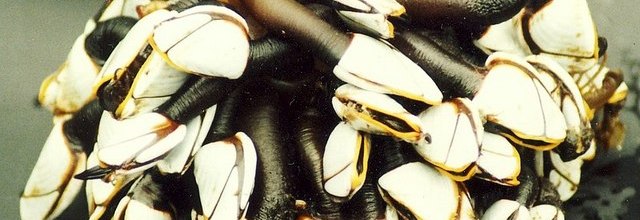Interactions/Adaptations
P. polymerus is a very
interactive creature for not being able to move around a whole
lot. It is a comm ensalism
type organism, so it lives on other organisms without harming
them. The barnacle lives on many objects like floating logs in
the ocean, turtle shells, fish, the bottoms of boats, rocks, and
other different surfaces. It can even create its own floating
home by forming a mucus bubble that hardens to live on. Boaters
specifically do not like barnacles because they stick to the
bottoms of their ships, causing the ships to move slower in the
water. Boaters use to ground their ships, meaning they scrapped
the bottom of their ships on rocks to try
ensalism
type organism, so it lives on other organisms without harming
them. The barnacle lives on many objects like floating logs in
the ocean, turtle shells, fish, the bottoms of boats, rocks, and
other different surfaces. It can even create its own floating
home by forming a mucus bubble that hardens to live on. Boaters
specifically do not like barnacles because they stick to the
bottoms of their ships, causing the ships to move slower in the
water. Boaters use to ground their ships, meaning they scrapped
the bottom of their ships on rocks to try
 and
remove the barnacles, causing severe damage to their ships.
P. polymerus has many predators. Some of its predators are
creatures like sea stars, tunacates, whelks, snails, and the
most common predator are birds or sea gulls.
and
remove the barnacles, causing severe damage to their ships.
P. polymerus has many predators. Some of its predators are
creatures like sea stars, tunacates, whelks, snails, and the
most common predator are birds or sea gulls.
To learn more about the different predators, follow these links: Snail Star Fish Bacteria Tunicates
The goose barnacle has some specific adaptations that help it live. Some of the adaptations are things like its shell, it is used for protection. The barnacle has a type of adhesive that allows it to stick to any surface. The adhesive they say is called superglue because it can stick to almost anything, like glass, metal, concrete, and plastic. The barnacle is able to move around using currents, creating its own mucus bubble to float on, and by using hosts such as fish, turtles, and other creatures of the sea the barnacle decides to stick to.
Click here to continue on to Facts
